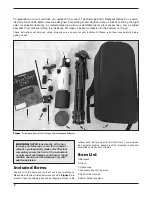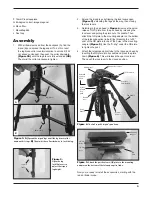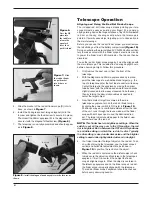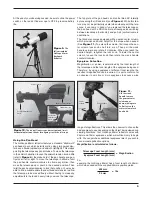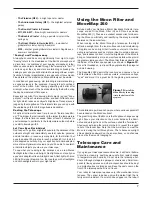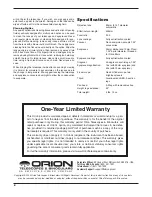
7
• The Pleiades (M45) – a bright open star cluster
• The Andromeda Galaxy (M31) – the brightest external
galaxy
• The Double Cluster in Perseus
• M11, M6 & M7 – three bright, summer star clusters
• The Beehive Cluster – A big, open star cluster in the
spring sky
• The Great Cluster in Hercules M13 – a wonderful
globular star cluster, spring & summer
• M22 – another grand globular star cluster in Sagittarius, a
summer constellation
“Seeing” and Transparency
Atmospheric conditions vary significantly from night to night.
“Seeing” refers to the steadiness of the Earth’s atmosphere at
a given time. In conditions of poor seeing, atmospheric turbu-
lence causes objects viewed through the telescope to “boil.” If
you look up at the sky and stars are twinkling noticeably, the
seeing is poor and you will be limited to viewing at lower magni-
fications. At higher magnifications, images will not focus clearly.
Fine details on the planets and Moon will likely not be visible.
In conditions of good seeing, star twinkling is minimal and imag-
es appear steady in the eyepiece. Seeing is best overhead,
worst at the horizon. Also, seeing generally gets better after
midnight, when much of the heat absorbed by the Earth during
the day has radiated off into space.
Especially important for observing faint objects is good “trans-
parency”—air free of moisture, smoke, and dust. All tend to scat-
ter light, which reduces an object’s brightness. Transparency is
judged by the magnitude of the faintest stars you can see with
the unaided eye (5th or 6th magnitude is desirable).
Cooling the Telescope
All optical instruments need time to reach “thermal equilibri-
um.” The bigger the instrument and the larger the temperature
change, the more time is needed. Allow at least 30 minutes for
your telescope to acclimate to the temperature outdoors before
you start observing with it.
Let Your Eyes Dark-Adapt
Don’t expect to go from a lighted house into the darkness of the
outdoors at night and immediately see faint nebulas, galaxies,
and star clusters—or even very many stars, for that matter. Your
eyes take about 30 minutes to reach perhaps 80% of their full
dark-adapted sensitivity. As your eyes become dark-adapted,
more stars will glimmer into view and you’ll be able to see faint-
er details in objects you view in your telescope.
To see what you’re doing in the darkness, use a red-filtered
flashlight rather than a white light. Red light does not spoil your
eyes’ dark adaptation like white light does. A flashlight with a red
LED light is ideal. Beware, too, that nearby porch, streetlights,
and car headlights will ruin your night vision.
Using the Moon Filter and
MoonMap 260
Included with your GoScope 80mm Backpack Refractor tele-
scope are an Orion Moon Filter (H) and Orion’s exclusive
MoonMap 260 (I). These are excellent accessories for observ-
ing the Moon comfortably and identifying the many incredible
features on the lunar surface.
When looking at the Moon through a telescope, the bright
reflected sunlight from the lunar surface can be overwhelming.
This glare can be so bright that it washes out most of the inter-
esting lunar features such as craters, rilles, mountains, and val-
leys, and reduces contrast. It cuts the brightness of the Moon to
bring out considerably more lunar surface details while provid-
ing greater viewing comfort. The Moon filter threads directly into
the barrel of the telescope eyepiece, as shown in
Figure 13
.
Once it is threaded on, just insert the eyepiece into the diagonal
and start viewing.
The DeepMap 260 depicts the locations and names of over
260 features on the Moon such as craters, mountains, valleys,
"seas" and more. It is a great tool for beginning astronomers.
This detailed map will even show you where various spacecraft
have landed on the Moon's surface!
The great thing about the Moon is that its phase changes every
night. Focus your attention on the border between the illumi-
nated and dark portions or the surface, called the “terminator”.
Shadows cast along the terminator help to reveal the rugged
relief of the landscape. Note that the worst time to view the
Moon is during the full Moon phase. That’s because sunlight
shines directly downward on the lunar surface, so no shadows
are cast by the moon's topography.
Telescope Care and
Maintenance
If you give your telescope reasonable care, it will last a lifetime.
Store it in a clean, dry, dust-free place, safe from rapid changes
in temperature and humidity. Do not store the telescope out-
doors, although storage in a garage or shed is okay. Small com-
ponents like eyepieces and other accessories should be kept
in a protective box or storage case. Keep the dust cover on the
front of the telescope when it is not in use.
Your refractor telescope requires very little mechanical main-
tenance. The optical tube has a smooth painted finish that is
fairly scratch-resistant. If a scratch does appear on the tube, it
Figure 13.
Install the
Moon filter by threading
it into the bottom of the
eyepiece.
Moon filter


